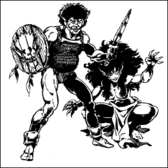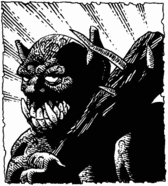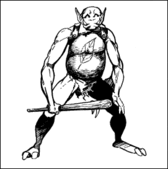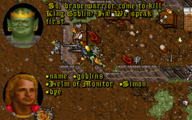Goblins
| Goblins | |
|---|---|
 Goblins, male and female, from Ultima VII Part Two manual | |
| First appearance: | Ultima III |
| Last appearance: | Ultima IX |
Goblins are a green-skinned humanoid race, native to such worlds as Britannia, Serpent Isle and Tarna. While often at odds with mankind, goblins are an intelligent and social species, and it has been demonstrated that they can coexist peaceably with other races. They appear in Ultima III, Ultima VII Part Two and Ultima IX, as well as in Ultima Underworld and Ultima Underworld II.
Description[edit]
Goblins of Sosaria and Britannia[edit]
In old Sosaria, goblins were originally the result of perverse arcane experiments carried out by unscrupulous mages. In time, the hellspawn Exodus rallied such creatures to be its servitors, and during the Age of Darkness numerous parties and patrols of goblins were found traveling the Sosarian landscape, assaulting travelers venturing too far from the safety of civilization. In the years that followed the daemon-machine's destruction, however, the bands of goblin folk were put to the sword by the men of the age. Goblinkind was, in fact, thought extinct by the time of Britannia's christening.
In spite of such a history, Lord British eventually put forth a decree ordering clemency for any of the "monstrous" folk who would join the cause of Virtue. At this time, delegations of goblins from a gray-skinned, mountain-dwelling tribe in the Serpent's Spine and a green-skinned clan from near Lake Venom appeared – answering to the sovereign's call and thereby proving their people not yet to be extinct. Several members of both groups later participated in the experimental colony created by the visionary Sir Cabirus, whereupon they put aside their racial hatreds and attempted to live in harmony with the other denizens of the Abyss.
After the death of Cabirus and the decline of his Abyssal Colony, however, old tensions flared up, causing the green and gray tribes to again quarrel against one another. At the time the Avatar was banished to the Abyss during the events of Ultima Underworld, many groups of goblins had given over to hostile banditry or had allied themselves with the evil wizard, Tyball.
It is not known exactly what became of these goblin colonists following their rescue from the erupting Abyss by the spirit, Garamon. While it was said that they came to resettle in Destard, no evidence of a colony was found there in later ages. After hundreds of years, a small scouting party of peaceful green goblins from an overworld clan were found foraging in the sewers of Castle Britannia, looking for fish, but little information could be gleaned of them regarding the state of their people.
Years after this brief encounter, goblins reappeared in force throughout the realm, once more as hostile and bloodthirsty as they had been in the Age of Darkness. It is unknown if this resurgence in goblin violence indicated a shift in attitudes of formerly peaceful tribes, or if new goblin nations of a more warlike temperament had emerged in the land.
Goblins of Tarna[edit]
Goblins are also present on the world of Tarna, where they had apparently gained the advantage in a prolonged war against mankind with the assistance of the Guardian during the events of Ultima Underworld II. When the Avatar journeyed to this land through the means of a gem within the Guardian's blackrock dome, the hero was landed within a prison tower within goblin territory. While a burgeoning resistance to the Guardian's intended rule through the goblins was slowly emerging under the guidance of Bishop at this time, it is not ultimately known what the fate of this world was.
Goblins of Serpent Isle[edit]
After the Lands of Danger and Despair were separated from the rest of old Sosaria, the goblins of the realm grew increasingly hostile, gathering in preparation to besiege the lands now solely ruled by the King of the White Dragon. Under increasing stress due to the encroaching hoarde, and wracked with rage and sorrow over his daughter's death, the king descended into madness. He eventually concocted a devilish "solution" to the goblin problem – murdering and torturing the sum of his kingdom's populace in a macabre banquet before throwing himself from his castle's battlements, proclaiming his people forever "safe" from the goblins' wrath. (It is said that goblins still possess superstitions about the Castle of the White Dragon to this day, and that they are loathe to approach it.)
For ages after this, the goblins flourished on these cold lands, withstanding the rise and fall of the Ophidian civilization and spreading across the mainland until the arrival of Erstam's settlers from Britannia. The knights of the old Montors, after founding the city of Monitor, became rapidly entangled with the scattered goblin tribes in a constant struggle for territory, which persisted throughout the ages, and was still ongoing by the time of the Avatar's arrival on the Serpent Isle in Ultima VII Part Two.
During the hero's adventures in Monitor and its surrounding lands, the once disparate goblin clans had come to be united under the singular leadership of Pomdirgun for some time. Under this solitary chieftain's command, the goblinfolk of the isle had slowly begun to gain the upper hand in their conflict with mankind through both sheer numbers and through guile – having taken apt advantage of the corrupt state of Monitor's officials to exploit the city's factionalism. While the Avatar eventually slew Pomdirgun, claiming the title of Knight Champion and reclaiming the stolen Helm of Courage, the goblins were eventually victorious in their efforts to overtake the City of Courage, and could be found encamped in the ruins of Monitor after the attack launched upon it by the Bane of Wantoness.
It is worth noting that the goblins of Serpent Isle display many behaviors and characteristics that differ from the goblins of Sosaria, Britannia and Tarna; the most famous among these being their penchant for eating human flesh and their use of human remains as ornaments and tools. In addition to these gruesome practices, the Serpent Islander goblins also are known for their extreme resistance to the cold, their love of strange pieces of rubbish and broken glass, and their long nightly revels. Due to this propensity for nocturnal festivities, experts in Monitor advise cunning pikeman to take advantage of the goblins' habit of sleeping long into the day, and suggest that raids against these monstrous clans be staged in the early morning.
Among these goblins, combat technique appears to be vary by gender, with male goblins employing swords, and heavy melee weaponry and females often attacking from a distance with blowgun darts. Both sexes further favor spears for both close and distant combat. Armour amongst these monstrous clans varies from simple skins to mail to antique armor.
Goblin Language[edit]
While in Britannia and Tarna the goblins of the realm seem to speak the same language as men, the alien goblinfolk of Serpent Isle are in possession of their own tongue. While none of it has been translated, the following phrases have been heard shouted by goblin warriors of that land:
- "Lorfag tar!"
- "Cra!!"
- "Eeeeeeeeerrrrrrr!"
- "Gloru gank!"
- "Kropf!"
- "Blakath!"
- "Ggblg!"
- "Urga jaag!"
- "Blaggar don!"
- "Grok..." (when dying)
Lore[edit]
| “ | The Goblins originated from forbidden arcane experiments performed on prisoners and other victims by demented, power-seeking mages. (It was for causes like these that magic was once banned in our lands.) During the Third Age of Darkness, Exodus bred the Goblins into an army dedicated to his wicked cause. Following his defeat, the survivors vanished from the face of Britannia — hunted down by vigilantes or banished to other realms. (In those times, the Goblins were so loosely bound to this world that a single spell could expel them from this plane of existence.)
It was only after our Proclamation went out, promising clemency to those primitive monster forms who would undertake to follow the Path of the Avatar, that the Goblins were rediscovered. A delegation of Goblinfolk appeared at the gates of Castle Britannia, asking for an audience with Lord British. Not just one but two species of Goblins had survived in hiding from the days of Exodus. The Gray Goblins, originally mountain dwellers, had skulked in the caves of the Serpent's Spine mountains. The forest-dwelling Green Goblins hid themselves by retreating into an underground river's channel, near the baneful lake called Venom. Today, virtuous Goblinfolk make up one-third of our community. There was a time when a Green Goblin would rather slay a Gray Goblin than any other enemy, but the Path of the Avatar has brought the tribes together as brothers. (Though the two species rarely come to blows nowadays, the Gray and the Green still attempt to outdo each other whenever possible in matters of Virtue. Old enmities die hard. - Corby) – from Memoirs of Sir Cabirus (Ultima Underworld)
|
|---|
| “ | The Goblin race originated in now-forbidden experiments among the earliest wizards of our lands, performed shortly before the period in which magic was banned outright in Britannia. Later, in the Age of Darkness, the man-machine Exodus bred the few remaining goblins into a substantial army with which he threatened the land. After the downfall of Exodus, the goblins fled into seclusion, forming two nations, the Grey and the Green. When the Age of the Avatar began, Lord British granted clemency to all "monstrous" folk who would pledge to follow the path of Virtue and it was thus that many goblins came to be accepted as members of our society, although they continued to keep largely to themselves, and to dwell in their own enclaves. I would advise thee, though, to be wary of any goblins you might meet on the road, far from the protection of a town, as they are a violent people, and some still cling to their old practice of banditry. Taken singly, a goblin is weaker than an average human, but for this reason they frequently travel in groups. |
|---|
| “ | The result of ancient magical experimentation (poorly conducted experimentation, I am sure) goblins only vaguely resemble the men from whom their forebears sprang. Although some attempt has been made to civilize them, surliness still dominates their nature. |
|---|
| “ | These wretched creatures would foul their mother's supper plate. At war with the world around, the goblin procreates broadly and rapidly as a defense. Though most goblins attack with an open-handed blow, the sergeants of any band carry weapons as totems of station. Leaders of the goblin party have a shaman's power and will cast magic from behind the warriors. Whatever the form of goblin, attack him directly, for he will not hesitate to seek the advantage. |
|---|
Notable Examples[edit]
- Ketchaval and Retichall: king and queen of the gray goblins in Ultima Underworld
- Vernix: king of the green goblins in Ultima Underworld
- Borne: commander of the Tarnan prison tower in Ultima Underworld II
- Pomdirgun: chieftain of the united goblin tribes in Ultima VII Part Two
Trivia[edit]
- On the Serpent Isle, Goblins have at times warred against the fur-covered gwani, and tribesmen of high regard and standing will occasionally be found wearing one of their pelts.
- Goblins were to be included in the canceled Ultima X. See Planned monsters for Ultima X for further details.





